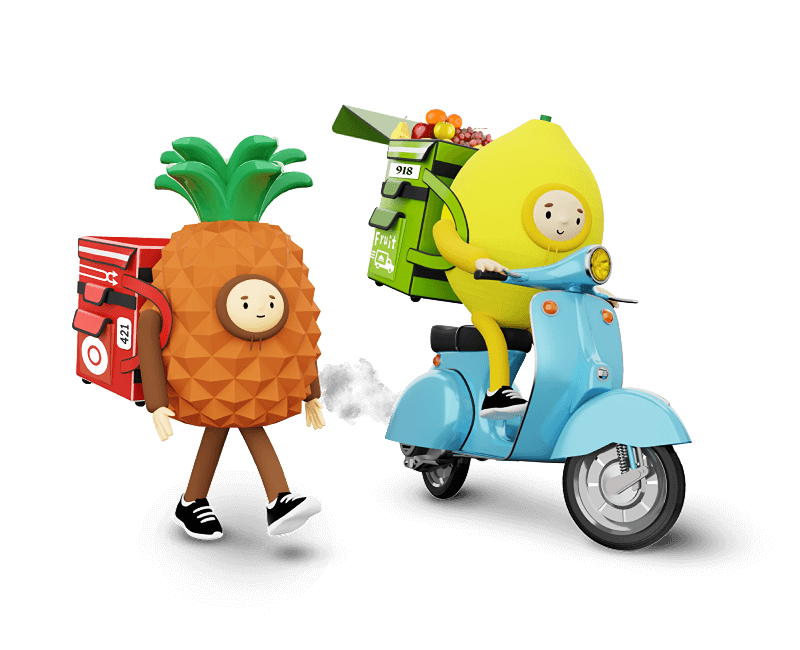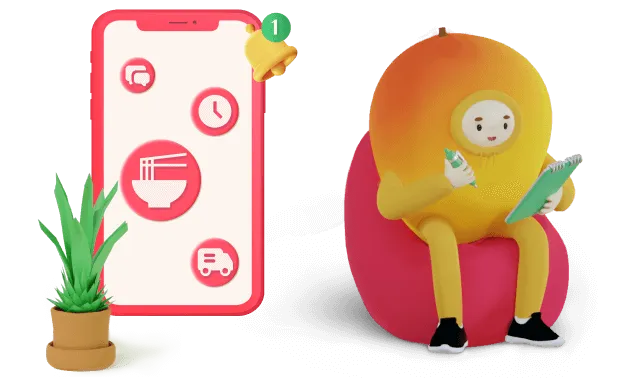Food Delivery App Development
Contemporary food delivery platforms serve as vital tools for automating food businesses. Additionally, they play a crucial role in boosting customer demand, serving as effective marketing instruments

Contemporary food delivery platforms serve as vital tools for automating food businesses. Additionally, they play a crucial role in boosting customer demand, serving as effective marketing instruments

Presently, 60% of smartphone users in Russia utilize applications to place food orders from diverse cafes, restaurants, and fast-food establishments. The food delivery market in the country has witnessed a remarkable 150% growth in the past year, accompanied by a notable 250% surge in the volume of orders
We will explore the pivotal elements involved in developing a food delivery application. Our recommendations aim to guide you in crafting high-quality, reliable software that will capture the interest of potential customers

Creating a food delivery app inevitably demands entrepreneurs to make strategically vital decisions. Based on the company's specific goals and business model, it is essential to determine whether to:

The first option is suitable for large chains that provide catering services. Businesses willing to invest in creating and maintaining their own delivery app can establish a dedicated customer base.

On the other hand, opting for an aggregator service allows online visibility of your menu on their platform, making it accessible to potential clients. This way, consumers discover your establishment and place orders. Utilizing an aggregator service provides businesses with the opportunity to swiftly build their customer base at a reasonable cost to the aggregator.
By simply adding your business to the platform, you become accessible to all users of the service. The aggregator service also offers a logistics solution to deliver your products to the customer. Examples of aggregators include Deliveri Club or Yandex Food, which provide their couriers and logistics for companies. The service's couriers transport food from their warehouses or establishments to customers.

If you lack the resources to develop the app and handle order deliveries internally, it's advisable to explore third-party food delivery services. In this scenario, your consumers will consist of users from your website, social media platforms, and those residing or working in proximity to your establishment. Notably, you won't incur the platform's commission for the order itself; rather, charges will be applied solely for the delivery to the customer.

Highlighting the positives, the primary advantage is the cultivation of your own customer base, accompanied by significant cost savings through the elimination of aggregator commissions.
Having your own application empowers you to offer users a swift and personalized ordering experience, exercise control over marketing campaigns (introduce custom sections with promotional offers, implement customer loyalty programs, gamification, and more). Additionally, it allows you to tailor the logistics service to suit your specific business needs.
However, drawbacks of this approach include the substantial implementation costs, the requirement for an in-house team of couriers, and the allocation of resources for its operation.
Opting for a pre-existing software aggregator is a suitable choice for businesses not aiming to pursue a distinctive marketing strategy or establish an extensive network of stores, cafes, or restaurants. In such cases, the primary focus lies in enhancing product quality and service for loyal customers.

A mobile application for food delivery is designed to facilitate effective interaction between the client and the company. Therefore, in the development of a mobile application, emphasis should be placed on the following stages of the «client-company» connection, specifically:
This process reflects a transparent system of interaction and increases customer satisfaction and loyalty to the application.

Not sure where to start?

a prototype for free
The best way to figure out what you need is visualization



An integral component of the system is the website, strategically designed to attract visitors and furnish them with information regarding available establishments and dishes. For effective management of offerings and orders, each restaurant establishment should possess its dedicated administrative panel. Additionally, a moderator admin panel is essential to oversee content quality on the platform and address any potential disputes.
For optimal accessibility, it is imperative to develop the app on both iOS and Android platforms. In the case of handling deliveries in-house, specialized software for drivers and couriers becomes a requisite.

The app should fulfill a minimum set of capabilities, including:


First, we implement the core functionality for your business. We create a personal account for registering your establishment on the platform; a public interface for integration with accounting services to acquire goods; tracking their quantity, availability, and other details. Additionally, we provide an interface for adding products and dishes with detailed descriptions, quantities, and other characteristics.
We develop a mobile application for customers based on the business-provided product database. We implement a user authentication system, a search system for the software, a cart for selected items, a purchase checkout system, order delivery tracking, and payment for selected items.
On the third stage, we integrate analytics for meticulous user behavior tracking. This enables us to identify and resolve emerging issues, ensuring continuous improvement of the interaction with the application.
On the fourth stage, we focus on creating a support system designed to resolve disputed issues. This system provides support to both customers and businesses, offering necessary assistance regarding the platform's usage.
We integrate the logistics system with the business platform and the mobile application for users. This functionality allows businesses to monitor the delivery of their products. For the buyer, it provides a clear understanding of where their order is and at which stage of the delivery process.
To achieve optimal efficiency, application development should consider incorporating a straightforward loyalty program for customers. Introducing a point accumulation system can incentivize customers to place repeat orders. Additionally, contemplating promotions that enhance customer engagement and contribute to increased sales is worthwhile.
The implementation of table reservation features is also essential to boost establishment attendance. Incorporating notification mechanisms can aid in demand management, elevate the average transaction value, and foster customer loyalty.

In addition to developing the program, it's crucial to factor in the costs of promotion and technical support, which may include:
Incorporating these expenditure items into the project budget ensures the sustainable long-term development of the application.

Selecting a software development contractor is a pivotal decision that significantly influences the success of the entire project. Consider the following suggestions when seeking a dependable developer:
Determining the precise cost of food delivery software is a challenging task. The final estimate is contingent on various factors, including the chosen business model, functionality, and developer rates. The selection of technology—whether fully native or based on ready-made templates—also plays a crucial role.
The lower end of the cost spectrum starts at $10,000 and encompasses basic functionality, with development taking a minimum of 3 months. For a project aiming to compete effectively with other applications, the cost may rise to approximately $20,000, with a projected timeline of up to six months.
It's important to note that these figures provide a general overview, and actual costs may vary based on specific requirements and development conditions.

Ask your question and we will answer you individually

In the rapidly evolving landscape of digital business technologies, the imperative to develop bespoke software has become indispensable. Yet, prior to committing to its development, a comprehensive analysis of market saturation is crucial. Additionally, it is essential to evaluate the financial capacity of your business, gauging its ability to incorporate additional expenses.
Conducting a thorough examination of the market and studying the experiences of successful companies is strongly recommended before taking decisive action. Creating an application is a substantial investment that holds the potential to elevate your business to an entirely new echelon.



